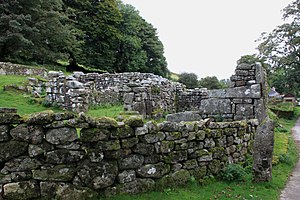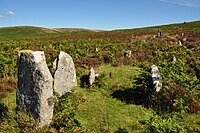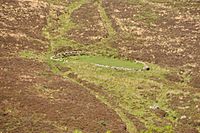Challacombe, Dartmoor
Challacombe, on Dartmoor was a village abandoned at some time in the Middle Ages. Its site is now a single farm, known as Challacombe Farm.
The site of the village is in southern Devon, in the midst of Dartmoor in the valley created by a head stream of the West Webburn River on the slopes of Challacombe Down. It is two and a half miles northwest of Widecombe-in-the-Moor. Just a mile to the north-east, on the hillside of Hound Tor, is Grimspound, a remarkable, abandoned Bronze Age village stillsurrounded by an impressive wall.
Field systems
There are prehistoric features at Challacombe also, but overlying them are extensive mediæval field systems, dating perhaps as far back as the 12th or 13th century. The most complete of these systems occupies much of Challacombe Farm, but also extends into Headland Warren, the hillside to the north of Challacombe Down. The land has been divided into large squarish blocks by low stony banks (often corn-ditch in form), historically known as 'wares', each further divided into narrow strips running along the contour, appearing as terraces or lynchets. This isi a striking example, preserved in the landscape though its abandonment, of the mediæval strip farming system.. The homesteads of the farmers lie abandoned close to the present day farm.
Mediæval field boundaries occur over much of Headland Warren; here, and on the top of Challacombe Down are also the faint traces of ridge and furrow, created by ploughing in the past.
Challacombe Down
Above the village is Challacombe Down, a Dartmoor hill climbing steeply to a summit at 1,510 feet.
The hillsides are scarred with open-cast tin mine-workings, looking as if a giant claw had raked the hillside. The workings have lomg since been abandoned and greened by time, but the Birch Tor and Vitifer Mining complex here has been described as ‘the most impressive mining landscape on Dartmoor’ and probably in the West Country’. The workings have a long timespan, from the Midle Ages through to the early 20th century, and involving streaming the valley bottoms, digging pits, excavating large steep-sided gullies and sinking shafts into the ground. Leats, channels and reservoirs were created to harness water supply. From the later period (late 18th century onwards) there is evidence of water being used (in the form of leats and reservoirs), to provide power to process the tin ore and there are scattered wheelpit, building and structure remains all over Headland Warren.
Extensive areas of both Challacombe and Headland Warren qualify for designation as Scheduled Ancient Monuments (SAMs).
The area forms part of the East Dartmoor SSSI and the Dartmoor SAC which are designated for their heathland habitats. The area is important for a number of UK BAP species including: Insects-Marsh Fritillary, Narrow-bordered Bee Hawkmoth, Bog Hoverfly. Birds- Ring Ouzel, Red Grouse, Snipe and wintering Hen Harrier.
References
- Headland Warren and Challacombe – Dartmorr National Park Authority
- Challacombe mediæval strip fields - Holiday in Dartmoor


